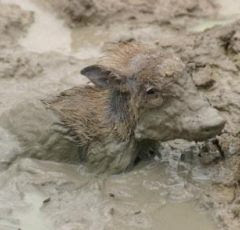Soil carbon deficit with and without erosion following replacement of natural vegetation with industrial farming - NOAA
These latest studies corroborate earlier ones by National Geographic - The Perrennial Solution, and the 40-year international study conducted by IFOAM All of them agree that perennials are thrifty. Their long roots hold on to soil, water, and fertilizer, which means less pollution. That the transition to organic farming, farm and ranch land must become a significant sink for greenhouse gasses, literally sucking excess greenhouse gases out of the atmosphere and sequestering them safely in the soil, where they belong.
Then there's organic farming's impressive ability to cut forty per cent of all greenhouse gas emissions that come from the use of fossil fuels and chemical-intensive industrial globalized system of agriculture. Organic farming reduces the output of carbon dioxide per unit of agriculturial output by 37-50%, reducing costs for the farmer and increasing our planet’s ability to absorb greenhouse gases.
How much? Since 1981, data from the Farming Systems Trial has revealed that soil under organic agriculture management can accumulate about 1,000 pounds of carbon per acre foot of soil each year. This accumulation is equal to about 3,500 pounds of carbon dioxide per acre taken from the air and sequestered into soil organic matter.
The experts in soil conservation, organic farming and perennial prairie grass restoration agree biodiversity and soils rich in organic matter are the best strategy for re-sequesting GHGs...and that these long used and proven approaches can mitigate current environmental damages while creating a cleaner and safer world for future generations...and that, though do-able, without major changes in land use...we're screwed.
Of course scientists never go on to include the unspoken and obvious next sentence because they feel it's not acceptable and 'cause their future employment may depend on dummying up. But i'll SHOUT IT: Corporate agriculture is damaging the world's underlying bioshere to such an extent that the lives of our descendants and those of countless other trillions of living things hinge on our action.
"Biodiverse organic farms produce more food and higher incomes than industrial monocultures. Mitigating climate change, conserving biodiversity and increasing food security can thus go hand in hand." - Vandana Shiva
On every scale, from backyard to global, each of us can act in parallel as part of the solution to the destruction being wrought by the GIANT. Another great aspect of Shiva's message of hope is that it is just as valid anywhere as everywhere.




